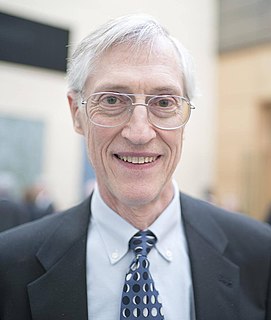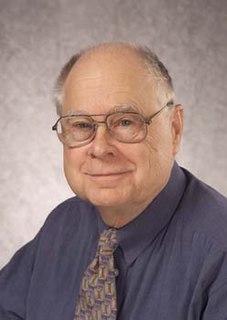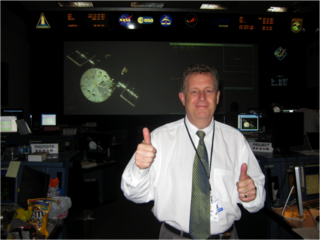Related Research Articles

The American Astronomical Society is an American society of professional astronomers and other interested individuals, headquartered in Washington, DC. The primary objective of the AAS is to promote the advancement of astronomy and closely related branches of science, while the secondary purpose includes enhancing astronomy education and providing a political voice for its members through lobbying and grassroots activities. Its current mission is to enhance and share humanity's scientific understanding of the universe as a diverse and inclusive astronomical community.

Lyman Spitzer Jr. was an American theoretical physicist, astronomer and mountaineer. As a scientist, he carried out research into star formation, plasma physics, and in 1946, conceived the idea of telescopes operating in outer space. Spitzer invented the stellarator plasma device and is the namesake of NASA's Spitzer Space Telescope. As a mountaineer, he made the first ascent of Mount Thor, with Donald C. Morton.

The James Webb Space Telescope (JWST) is a space telescope and an international collaboration among NASA, the European Space Agency (ESA), and the Canadian Space Agency (CSA). The telescope is named after James E. Webb, who was the administrator of NASA from 1961 to 1968 and played an integral role in the Apollo program. It is intended to succeed the Hubble Space Telescope as NASA's flagship mission in astrophysics. JWST was launched on 25 December 2021 on Ariane flight VA256. It is designed to provide improved infrared resolution and sensitivity over Hubble, viewing objects up to 100 times fainter than the faintest objects detectable by Hubble. This will enable a broad range of investigations across the fields of astronomy and cosmology, such as observations up to redshift z≈20 of some of the oldest and most distant objects and events in the Universe, and detailed atmospheric characterization of potentially habitable exoplanets.

Eleanor Margaret Burbidge, FRS (née Peachey; 12 August 1919 – 5 April 2020) was a British-American observational astronomer and astrophysicist. In the 1950s, she was one of the founders of stellar nucleosynthesis and was first author of the influential B2FH paper. During the 1960s and 70s she worked on galaxy rotation curves and quasars, discovering the most distant astronomical object then known. In the 1980s and 90s she helped develop and utilise the Faint Object Spectrograph on the Hubble Space Telescope. Burbidge was well known for her work opposing discrimination against women in astronomy.

John Mace Grunsfeld is an American physicist and a former NASA astronaut. He is a veteran of five Space Shuttle flights and has served as NASA Chief Scientist. His academic background includes research in high energy astrophysics, cosmic ray physics and the emerging field of exoplanet studies with specific interest in future astronomical instrumentation. After retiring from NASA in 2009, he served as the Deputy Director of the Space Telescope Science Institute in Baltimore, Maryland. In January 2012, he returned to NASA and served as associate administrator of NASA's Science Mission Directorate (SMD). Grunsfeld announced his retirement from NASA in April 2016.

Henry Way Kendall was an American particle physicist who won the Nobel Prize in Physics in 1990 jointly with Jerome Isaac Friedman and Richard E. Taylor "for their pioneering investigations concerning deep inelastic scattering of electrons on protons and bound neutrons, which have been of essential importance for the development of the quark model in particle physics."

Robert P. Kirshner is an American astronomer, Chief Program Officer for Science for the Gordon and Betty Moore Foundation, and the Clowes Research Professor of Science at Harvard University. Kirshner has worked in several areas of astronomy including the physics of supernovae, supernova remnants, the large-scale structure of the cosmos, and the use of supernovae to measure the expansion of the universe.

John Cromwell Mather is an American astrophysicist, cosmologist and Nobel Prize in Physics laureate for his work on the Cosmic Background Explorer Satellite (COBE) with George Smoot.

Heidi B. Hammel is a planetary astronomer who has extensively studied Neptune and Uranus. She was part of the team imaging Neptune from Voyager 2 in 1989. She led the team using the Hubble Space Telescope to view Shoemaker-Levy 9's impact with Jupiter in 1994. She has used the Hubble Space Telescope and the Keck Telescope to study Uranus and Neptune, discovering new information about dark spots, planetary storms and Uranus' rings. In 2002, she was selected as an interdisciplinary scientist for the James Webb Space Telescope.

Steven J. Dick is an American astronomer, author, and historian of science most noted for his work in the field of astrobiology. Dick served as the Chief Historian for the National Aeronautics and Space Administration from 2003 to 2009 and as the Baruch S. Blumberg NASA/Library of Congress Chair in Astrobiology from 2013 to 2014. Before that, he was an astronomer and historian of science at the United States Naval Observatory in Washington, DC, from 1979 to 2003.
George Henry Rieke, a noted American infrared astronomer, is former Deputy Director of the Steward Observatory and Regents Professor of Astronomy and Planetary Sciences at the University of Arizona in Tucson. He led the experiment design and development team for the Multiband Imaging Photometer for Spitzer (MIPS) instrument on NASA's infrared Spitzer Space Telescope, and currently chairs the science team of the Mid-Infrared Instrument for the James Webb Space Telescope.

Laurie Leshin is an American scientist and academic administrator serving as the 16th president of Worcester Polytechnic Institute. She is the first female president in the institution's 150-year history. Leshin's research has focused on geochemistry and space science.

William J. (Bill) Borucki is a space scientist who worked at the NASA Ames Research Center. Upon joining NASA in 1962, Borucki designed the heat shields for Apollo program spacecraft. He later turned his attention to the optical efficiency of lightning strikes in the atmospheres of planets, investigating the propensity that these lightning strikes could create molecules that would later become the precursors for life. Subsequently, Borucki's attention turned to extrasolar planets and their detection, particularly through the transit method. In light of this work, Borucki was named the principal investigator for NASA's Kepler mission, launched on March 6, 2009 and dedicated to a transit-based search for habitable planets. In 2013, Borucki was awarded the United States National Academy of Sciences's Henry Draper Medal for his work with Kepler. In 2015 he received the Shaw Prize in Astronomy.

Charles Mattias ("Matt") Mountain is currently the President of the Association of Universities for Research in Astronomy which designs, builds, and operates telescopes and observatories for the National Science Foundation (NSF) and the National Aeronautics and Space Administration (NASA). AURA's NASA center is the Space Telescope Science Institute (STScI), responsible for the science mission for the Hubble Space Telescope, the science and operations for the James Webb Space Telescope, and the MAST data archive. AURA's NSF centers are Gemini Observatory, the National Optical Astronomy Observatory (NOAO), and the National Solar Observatory (NSO). Dr. Mountain and AURA are also responsible for the NSF construction projects: the Daniel K. Inouye Solar Telescope (DKIST) on Haleakalā, Hawaii and the Large Synoptic Survey Telescope (LSST) on Cerro Pachón in Chile.

Roger D. Launius is an American historian and author of Lithuanian descent, a former chief historian of NASA. He retired in 2016 as Associate Director for Collections and Curatorial Affairs for the Smithsonian National Air and Space Museum in Washington, D.C.. Launius is a consulting historian in air and space history. He has written many books on space flight, and also published on the history of the Latter Day Saint movement.

Stefi Baum is an American astronomer. The American Astronomical Society honored her work by awarding her the Annie J. Cannon Prize in 1993. Baum helped to develop the Hubble Space Telescope and, starting in 2004, was the director of Rochester Institute of Technology’s Chester F. Carlson Center for Imaging Science.

Marcia Jean Rieke is an American astronomer. She is a Regents' Professor of Astronomy and associate department head at the University of Arizona. Rieke is the Principal Investigator on the near-infrared camera (NIRCam) for the James Webb Space Telescope (JWST). She has also served as the deputy-Principal Investigator on the Near Infrared Camera and Multi-Object Spectrometer (NICMOS) for the Hubble Space Telescope (HST), and as the co-investigator for the multiband imaging photometer on the Spitzer Space Telescope, where she also acted as an outreach coordinator and a member of the Science Working Group. Rieke was also involved with several infrared ground-based observatories, including the MMT Observatory in Arizona. She was vice chair for Program Prioritization of the Astro2010 Decadal Survey Committee, "New Worlds, New Horizons". Marcia Rieke is considered by many to be one of the "founding mothers" of infrared astronomy, along with Judith Pipher.
References
- ↑ "Smith, Robert". Fellows. Alberta Institute for American Studies. Archived from the original on July 6, 2011. Retrieved May 27, 2011.
- ↑ "The 2020 Leroy E. Doggett Prize Awarded to Robert W. Smith". AAS Historical Astronomy Division. American Astronomical Society. 2020. Retrieved August 28, 2020.